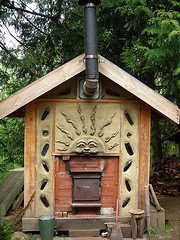 I've been thinking a lot about natural building lately. Here in the US, we are practically forced into occupying homes that are expensive and destructive to the environment. I met a woman last weekend who lives in a yurt and has an outdoor composting toilet. She paid $3,000 for the yurt, making it a dignified way to live on a low income. She's worried because what she's doing on her own property is illegal. She's living in a safe, efficient, inexpensive structure that is extremely light on the land, an it's illegal under her county building codes.
I've been thinking a lot about natural building lately. Here in the US, we are practically forced into occupying homes that are expensive and destructive to the environment. I met a woman last weekend who lives in a yurt and has an outdoor composting toilet. She paid $3,000 for the yurt, making it a dignified way to live on a low income. She's worried because what she's doing on her own property is illegal. She's living in a safe, efficient, inexpensive structure that is extremely light on the land, an it's illegal under her county building codes.A conventional home that costs $200,000 may end up costing $400,000- $600,000 including interest paid to the bank and all fees. If you can save money and cut out the bank, you might be able to build your own code-compliant house for $100,000 or less, including the land. It isn't difficult to see the financial advantage of building yourself.
Conventional homes are also highly destructive to the environment, partly due to materials and partly due to inefficiency of the completed structure. As usual, I'm looking for alternatives.
One possibility that has caught my imagination is a material called cob. It's made of sand, clay and straw that's mixed together and allowed to harden into a durable monolithic structure. It's a traditional form of construction throughout the world, but the word comes from the UK, where thousands of cob buildings are still standing after up to 500 years. It's similar to adobe, except bricks are not used.
Cob uses inexpensive materials that can typically be gathered on-site or nearby, and have a low embodied energy. The straw is an agricultural waste product and is very inexpensive. Building with cob doesn't require much skill or strength. It can produce highly efficient structures in appropriate climates due to its high thermal mass. It's also extremely durable if cared for properly. Cob has all the attributes of an effective vernacular building technique.
It's also not code-compliant in most places in the US, but that may change as it becomes more familiar. That's also a reason why I'm considering alternatives like strawbale and timberframe construction. It's possible to build code-compliant cob houses in the UK.
Last weekend I went to a "Basics of Cob" workshop at the Ancient Earth school of natural building on Whidbey island. We learned how to mix cob and then we built a bench out of it. The bench will eventually be coated in a smooth earthen or lime plaster. Cob is an amazing material. It's sculptable when wet, but becomes very hard when it dries. It's compatible with a number of other natural building techniques like strawbale and light straw-clay. It really is at the intersection of construction and sculpting. When you build with cob, you aren't limited to straight lines and right angles, so you can create spaces that are highly functional and aesthetic, while also being space-efficient. Here are some photos from the workshop:





You brought up an idea that I was also thinking about recently. Most people assume building codes and regulations are only for safety and efficiency (and many of them are) but, like with the FDA, it wouldn't be surprising if over time rules were added or amended for the benefit of special interests (ie. corporations, politicians, union officials etc).
ReplyDeleteAnyway, it amazes me that living in a well-designed yurt could be illegal while there's so many homeless living on the street, in boxes or tents.
Chainey,
ReplyDeleteI appreciate the links. I'm still trying to figure out what all my options are, so that's useful.
Reid,
ReplyDeleteI tend to think the main reason the building codes are set up like that is simply that nearly every building is built conventionally. They aren't friendly to the alternative owner-builder because there are so few of them. Of course, it doesn't hurt the construction industry that they make it daunting to build your own shelter. The yurt thing is definitely inexcusable.
"It's possible to build code-compliant cob houses in the UK"
ReplyDeleteOh! Hmmmmmm interesting. Didn't know that.
Peter
I agree with Reid, I wouldn't be surprised if existing regulations had a lot to do with pressure from special interests. The point about homelessness is a good one, too. What's the alleged argument for prohibiting structures like yurts as permanent dwellings?
ReplyDeleteIt's ironic, considering that yurts and cob houses are both ancient, time-tested building styles. They're more sustainable and safer than some of the flimsy and wasteful structures we see that are code-compliant, and they're more beautiful too. I remember seeing lovely cob houses in England.
But just like with food, we all know that traditional, simple, and homemade things can't be safe, and we need to replace them with innovations. Maybe I'll build my next house out of margarine.
I think it has to do with a lack of plumbing. The authorities imagine that if you don't have municipal plumbing or septic, you're just crapping all over the place and it's unsanitary.
ReplyDeleteThey don't make allowances in most places for more sustainable options like composting toilets.
Why not have plumbing in your cob house or yurt? As long as you are not planning on moving the yurt, of course. You could build a "plumbing cottage" with a kitchen and bathroom to stand right next to the yurt if it weren't convenient to plumb the yurt.
ReplyDelete